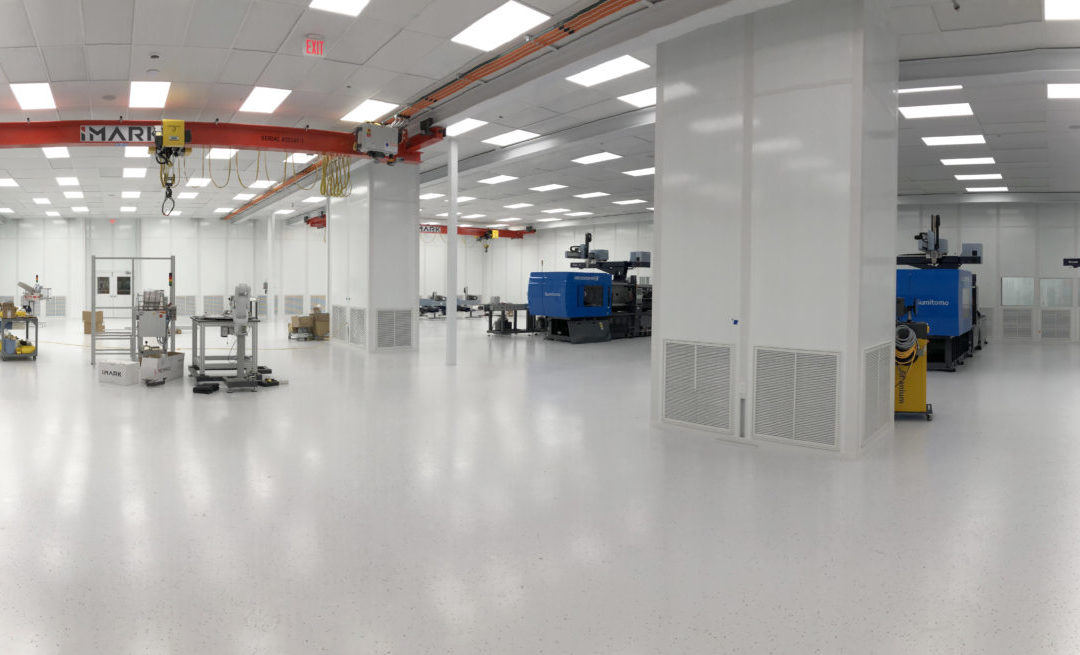Plastic is used for various tools and applications in everyday life. But where do those plastic components come from, and how are they made? Plastic injection molding!
Plastic injection molding is the primary method of manufacturing for most plastic tools, packaging, components, appliances, and more. As most professionals in the industry know, plastic injection molding is a complex process that must be conducted in a controlled environment like a cleanroom. Let’s dive deeper into why.
What Is Plastic Injection Molding?
Plastic injection molding is a process used to manufacture a variety of plastic parts and devices. It involves placing molten plastic into a metal mold, then allowing it to cool until a solid structure is formed. It is used for a variety of industrial applications, including (but not limited to):
- Medical devices
- Pharmaceutical packaging
- Food and beverage packaging
- Aerospace parts
- Automotive parts
- Parts used for the research and development of new products
So why does plastic injection molding need to be done within a cleanroom environment?
Why Does It Require a Cleanroom?
Well, there are many sensitive applications where contamination can be detrimental to a finished plastic product’s safety and performance. For applications like aerospace and automotive part manufacturing, contamination during the injection molding process could decrease the level of performance. And for applications involving medical devices, food, or other consumables, contamination during the injection molding process could put human lives at risk.
Therefore, it’s necessary to have a cleanroom that’s designed to reduce the risk of contamination while operators and equipment create these plastic components. Doing so not only ensures great product performance and consumer safety, but also protects you from having to start over and manufacture replacement products — effectively saving you from losses in efficiency and profitability.
Unique Challenges for Plastic Injection Molding Cleanrooms
The plastic injection molding sector faces a unique set of challenges when it comes to cleanroom design and operations. These challenges are mostly due to the nature of the process and the specific types of equipment used during it. Here are a few of those challenges you’ll want to consider when planning your own injection molding cleanroom:
- Minimizing contamination from cleanroom personnel
- Minimizing contamination from cleanroom equipment
- Accommodating large pieces of injection molding cleanroom equipment, such as mold cranes and mold presses
- Allowing direct access for overhead mold cranes to enter the cleanroom through ceiling access panels
- Allowing mold cranes to be grounded outside of the cleanroom at all times (if possible)
How to Design a Safe & Effective Plastic Injection Molding Cleanroom
So how can you design a plastic injection molding cleanroom that operates efficiently and meets all of the criteria above? Here are some tips from our experts:
- ISO Classification — Most plastic injection molding cleanrooms are ISO Class 7 or 8. However, this can vary depending on your specific application.
- Type of Cleanroom — All three types of cleanrooms can be used for plastic injection molding. It’s best to ask your cleanroom manufacturer which is most suitable for your specific application.
- Cleanroom Size — There isn’t a minimum or maximum size requirement that your plastic injection molding cleanrooms need to meet. Just make sure it’s big enough to house the large furniture and machinery you’ll be using. Remember, choosing modular construction is a smart idea if you anticipate expanding in the future.
- Cleanroom Pressure — Your plastic injection molding cleanroom should operate under positive pressure in order to prevent harmful particles from entering and disturbing your process.
- Special Equipment — Plastic injection molding cleanrooms house a few unique types of equipment, most importantly mold cranes. In most cases, you will need to consider a ceiling hatch to allow your mold crane, which is a potentially high source of contamination, to be kept outside of your cleanroom. That way, only part of the machine enters your cleanroom for tool/mold changing purposes. Another important decision to make is choosing electric machines instead of hydraulic machines, which can also reduce the amount of contamination that enters the space.
For an example of what a plastic injection molding cleanroom may look like, check out one of our latest projects here.
Work With the Plastic Injection Molding Cleanroom Experts at Angstrom Technology
In order for injection molding applications to be safe, effective, and repeatable, cleanrooms are necessary. If you’re looking to design a plastic injection molding cleanroom of your own, contact our team at Angstrom Technology. We’ll listen to your facility’s specific needs, then provide a turnkey cleanroom solution that meets each one of them.



